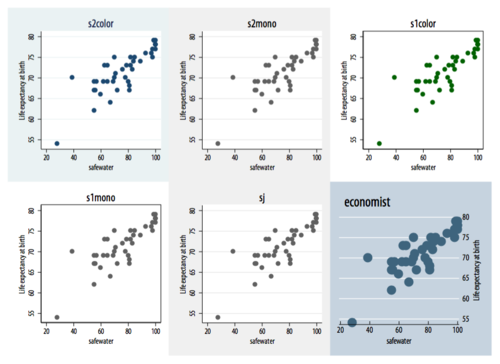
The graph command creates visualizations which have a Y-axis and a categorical axis. The graph command creates visualizations of one or more variables in the dataset. Specific Visualization Approaches The graph command Rendering the Graph window is computationally costly in Stata and is best avoided whenever possible. To save processing time when combining graphs, consider rendering the underlying graphs using the nodraw option, which saves graph rendering until the combined graph is drawn. The user-written grc1leg command may also be useful when all of the visualizations included in the final image are intended to share a common legend. The graph combine command provides many options for customizing the layout and alignment of the graphs included. Sysdir set PERSONAL " $ /outputs/f-discontinuity-4.gph" /// Note the file type is explicit in the file path extension for the graph export command:
#Stata colors code#
One way to implement these settings is with code like the following. (Similarly, the saving() option is discouraged in all other uses.) gph files unless you intend to combine graphs later. You should never use graph save to create. These may not be natively viewable in your operating system. However, PNG images will typically be insufficient quality for print media journals may prefer "lossless" TIFF or EPS images. PNG images tend to be of reasonable quality and natively viewable on all operating systems as well as on web browsers when stored in places like GitHub and Zenodo. The choice of file type is also important.

The aspect ratio is set using the ysize() or xsize() options, with integers as the arguments. Two further primary settings will be desired when creating graphs for publication purposes: the file type of the exported image file and the aspect ratio (width-to-height) of the file. For -graph- graphs global graph_opts_1 /// Yscale(noline) ylab(,angle( 0) nogrid) /// Xscale(noline) xtit(,placement(left) justification(left)) /// Title(, justification(left) color(black) span pos( 11)) /// For -twoway- graphs global graph_opts /// These settings are implemented as follows:

These typically include key elements like marker shapes and sizes coloration of lines, markers, and fill elements transparency and added text and so on.
#Stata colors full#
When drawing a graph, refer to the specific help file for its command to understand the full range of specific options available. There are an enormous number of options available for each specific type of graph in Stata, and we will not cover those here.

Each has specific use cases, strengths, and weaknesses, and it is important to be familiar with the abilities and limitations of each when considering which to use to create a particular visualization. Stata graphics are typically created using one of four command types. 3.4 User-written visualization commands.


 0 kommentar(er)
0 kommentar(er)
